
How to Write a Letter of Introduction (With Examples)
By Priya Jain
Published: January 22, 2024
Writer & Career Coach
Writing a letter of introduction serves as a tool for individuals and businesses to establish new connections, explore opportunities, or introduce services and products. An effectively written letter of introduction can open doors to job opportunities, business collaborations, and networking.
Whether you’re a freelancer seeking new clients, a business looking to forge new partnerships, or an individual exploring job opportunities, a compelling introduction letter can set the stage for fruitful interactions.
In this article, we explain what a letter of introduction is, explore what to include, and give examples you can use while creating your letter.
What Is a Letter of Introduction?
A letter of introduction is a document that introduces one party to another. It can serve various purposes in different contexts, including professional, academic, or personal settings.
This letter can be used to introduce oneself or by someone else to introduce a third party. The key purpose is establishing a connection or a rapport with the recipient, usually with a specific goal, such as exploring job opportunities, proposing business collaborations, or extending networks.
Individuals can use letters of introduction in social settings, like joining a new club or group, where you want to introduce yourself to the members. These letters often introduce a third party, like a colleague or a friend, to your contacts. This can be particularly helpful in professional networking or recommending someone for a job or project .
The Difference Between a Letter of Introduction and a Cover Letter
A letter of introduction and a cover letter are very different. Letters of introduction are generally used when you want to establish a new relationship that may or may not be job-related. It could be an introduction to a potential business partner, a networking contact, or a new community or group.
On the other hand, a cover letter is job-related. It’s sent alongside a resume when applying for a job. The cover letter focuses on why the applicant is suitable for a specific job, highlighting skills and experiences directly relevant to the job description. It’s more tailored to a particular role or company.
Letter of Introduction Examples
Here are some examples you can take inspiration from:
Job Application Letter of Introduction
This letter aims to introduce yourself to a potential employer, highlight relevant skills and experiences, express interest in the position, and provide a glimpse of your personality.
You can use this example to write a job application introduction letter:
Dear [Hiring Manager’s Name],
I am writing to express my keen interest in the [Job Title] position at [Company Name]. With [X years] of experience in [relevant field/industry], I have developed a comprehensive skill set that aligns with your team’s requirements.
My experience at [Previous Company] involved [mention key responsibilities or projects related to the new job]. I am particularly excited about the opportunity at [Company Name] because of [reasons specific to the company or role].
Enclosed is my resume, which further outlines my achievements. I would appreciate the opportunity to discuss how my experience and skills can contribute to the continued success of [Company Name].
Thank you for considering my application. I look forward to the possibility of contributing to your esteemed team.
[Your Name] [Your Contact Information]
Networking Introduction Letter
A networking introduction letter is a valuable tool for establishing new professional connections . It’s a way of introducing yourself to someone in your industry or field whom you haven’t met but wish to connect with for networking purposes.
Here’s an example:
Dear [Contact’s Name],
I hope this message finds you well. I am [Your Name], currently working as a [Your Job Title] at [Your Company]. I came across your profile on [LinkedIn/Professional Event] and was impressed by your extensive experience in [relevant field/industry].
I am reaching out to expand my professional network in the [specific industry or field] and would value the opportunity to learn from your insights. [Mention any mutual connections or shared interests, if applicable].
If you are open, I would appreciate talking with you briefly. I want to hear about your experiences, particularly regarding [specific topic or question].
Thank you for considering my request. I understand the value of your time and would be flexible to accommodate your schedule.
Best regards,
Cold Outreach Letter of Introduction
A cold outreach letter of introduction is used when contacting someone who does not know you or is not expecting your communication. It’s typically used professionally to introduce yourself, your company, or your products/services to a potential client, partner, or employer.
Here’s an example:
Dear [Recipient’s Name],
My name is [Your Name], and I am the [Your Position] at [Your Company]. I am reaching out to introduce our company and the innovative solutions we offer in [specific service or product area].
I believe that [Recipient’s Company] could significantly benefit from our [services/products], especially in [specific area of improvement or opportunity you’ve identified in their business]. We have partnered successfully with companies like yours, such as [mention any relevant clients or case studies], and achieved [mention specific results or improvements].
I would love the opportunity to discuss this further with you. Would you be available for a brief call next week? I am also attaching a brief overview of our services for your reference.
Thank you for your time, and I look forward to working together.
Warm regards,
Letter of Introduction Template
Creating a letter of introduction involves a structured approach to presenting your information effectively.
Here’s a template that you can adapt based on your specific needs:
[Your Name] [Your Address] [City, State, Zip Code] [Email Address] [Phone Number]
[Recipient’s Name] [Recipient’s Title] [Company/Organization Name] [Company Address] [City, State, Zip Code]
Dear [Recipient’s Name],
[Introductory Paragraph: Briefly introduce yourself, stating your name and current position or role. Explain how you came across the recipient, their work, or their organization.]
[Second Paragraph: State the purpose of your letter. Are you seeking a job opportunity, looking to network, or proposing a collaboration? Be specific about your intentions and why you are contacting this particular individual or company.]
[Third Paragraph: Concisely overview your relevant background and experience. Focus on key aspects of your career or education that align with the purpose of your letter.]
[Fourth Paragraph: Highlight one or two significant accomplishments or skills. Use specific examples demonstrating your capabilities and how they relate to the recipient’s needs or interests.]
[Fifth Paragraph: Mention any personal qualities or soft skills that set you apart and are relevant to the context of your introduction. Relate these traits to how they can be beneficial in achieving the goals outlined in your letter.]
[Call to Action: Clearly state what you hope to achieve with this letter. Whether it’s a follow-up meeting, a phone call, or further discussions, provide a clear action you’d like the recipient to take.]
Thank you for taking the time to read my letter. I am very interested in [discussing further, learning more about, etc.] and look forward to the possibility of [working together, meeting you, etc.]. Please contact me at [your email address] or [phone number].
[Your Name] [Attachments: Mention attachments such as your resume, portfolio, or other relevant documents.]
What You Need to Include in a Letter of Introduction
Incorporating specific elements in your letter of introduction can significantly enhance its effectiveness.
Here’s a breakdown of what to include following your provided structure:
Begin with a formal greeting. This is the initial greeting and sets the tone for the letter. Use a formal tone like “Dear [Recipient’s Name]”. If the recipient’s name is unknown, “Dear Hiring Manager” or “To Whom It May Concern” are alternatives. Personalizing the salutation, however, is preferable if you know the recipient’s name.
Introduction
Introduce yourself by stating your name and your current position or role in a professional context. This section should be brief, offering a snapshot of who you are. For instance, “My name is Jane Doe, and I am a Marketing Manager at XYZ Corporation.”
Purpose of the Letter
Clearly articulate why you are writing this letter. This might be to introduce yourself in a job search context, to propose a business collaboration, or to establish a new professional relationship. Be specific about why you’re contacting this particular individual or organization.
Background Information
Provide a concise overview of your professional background relevant to the purpose of your letter. This could include your current job, professional journey, or key areas of expertise. The aim is to give the reader context about your professional standing.
Relevant Accomplishments
Highlight significant achievements that are pertinent to the recipient. These could be successful projects you’ve led, awards you’ve won, or specific contributions you’ve made in previous roles. The objective is to showcase your competence and success in areas relevant to the letter’s purpose.
Personal Qualities
Share personal attributes that make you well-suited for the intended purpose of your letter. For instance, you might emphasize qualities like leadership, innovation, or collaborative skills if you are applying for a job. This part is about showing your personality and fit.
Call to Action
This is a crucial component where you suggest the next steps. It could be a request for a follow-up meeting, a phone call, or an invitation to review your application. Make it clear what you want the recipient to do next.
Conclude your letter with a formal and professional closing. Common closings include “Sincerely”, “Best regards”, or “Kind regards”, followed by your full name. This part signifies the end of your letter respectfully.
Attachments
If you include additional documents, such as a resume or portfolio, mention them here. For example, “Enclosed, please find my resume, which provides further details about my professional experience.”
What Not to Include in a Letter of Introduction
When writing a letter of introduction, it’s important to be aware of certain elements that should be avoided.
Here are what not to include:
Unsubstantiated Claims
Your letter should avoid making broad statements about your abilities or achievements without providing specific examples or evidence to support them. For instance, rather than simply stating that you’re an excellent communicator, provide a brief example or mention a relevant accomplishment demonstrating this skill. The goal is to be as concrete and specific as possible to build credibility.
Clichés and Overused Phrases
Avoid overused phrases and clichés that don’t add substantive information to your introduction. Phrases like “team player,” “hard worker,” or “go-getter” are commonly used and don’t distinguish you from other candidates. Instead, use unique descriptions specifically tailored to your experiences and qualifications.
Unrealistic Promises
Be cautious about making promises or commitments that you might not be able to fulfill. Overpromising to impress can backfire if you cannot deliver on those promises later. It’s important to be honest and realistic about what you can offer to the potential employer or contact.
Best Practices for Writing Letters of Introduction
When writing a letter of introduction, following these best practices can greatly enhance the effectiveness and professional impact of your letter:
Tailoring the Letter to the Audience
By researching and familiarizing yourself with the recipient’s work and organization, you can ensure that your letter speaks directly to their needs and interests. Personalization in the letter demonstrates that you have taken the time to understand who they are and what they value, which can significantly increase the effectiveness of your message.
Keeping It Concise and Focused
An effective letter conveys your message in a clear, succinct manner. Long letters can dilute the impact of your key points and lose the reader’s interest.
Structuring your letter with a clear beginning, middle, and end helps maintain this focus. The introduction should grab attention, the body should elaborate on your purpose and relevant qualifications, and the conclusion should reiterate your intent and suggest the next steps.
Showcasing Personality and Authenticity
An impactful letter is about what you say and how you say it. Infusing your letter with genuine personality and authenticity makes your message resonate more with the recipient. It’s about striking the right balance between professional decorum and personal touch.
Sharing your motivations, interests, or perspectives in a way that aligns with the professional context can make your letter memorable and establish a more personal connection with the recipient.
Proofreading for Clarity and Professionalism
The final yet crucial step in drafting your letter is thorough proofreading. This step is imperative for ensuring your letter is free from grammatical errors and typos and communicates your message.
A well-written and professionally presented letter reflects your attention to detail and commitment to quality. Having someone else review your letter is often beneficial, as a fresh pair of eyes can catch errors and provide feedback on your message’s overall clarity and tone.

About the Author
Read more articles by Priya Jain
How to Write a Cover Letter in 2024 + Examples

After weeks of heavy job search, you’re almost there!
You’ve perfected your resume.
You’ve short-listed the coolest jobs you want to apply for.
You’ve even had a friend train you for every single interview question out there.
But then, before you can send your application and call it a day, you remember that the job ad requires a cover letter.
Now you’re stuck wondering how to write a cover letter ...
Don’t panic! We’ve got you covered. Writing a cover letter is a lot simpler than you might think.
In this guide, we’re going to teach you how to write a cover letter that gets you the job you deserve.
- What’s a cover letter & why it’s important for your job search
- How to write a convincing cover letter that gets you the job (step-by-step!)
- How to perfect your cover letter with the Novoresume free checklist
- What excellent cover letter examples look like
New to cover letter writing? Give our resumes 101 video a watch before diving into the article!
So, let’s get started with the basics!
What is a Cover Letter? (and Why It’s Important)
A cover letter is a one-page document that you submit as part of your job application (alongside your CV or Resume).
Its purpose is to introduce you and briefly summarize your professional background. On average, your cover letter should be from 250 to 400 words long .
A good cover letter can spark the HR manager’s interest and get them to read your resume.
A bad cover letter, on the other hand, might mean that your application is going directly to the paper shredder. So, to make sure this doesn’t happen, it’s essential to know how to write a convincing cover letter.
How does a good cover letter look, you might ask. Well, here’s an example:

Keep in mind, though, that a cover letter is a supplement to your resume, not a replacement. Meaning, you don’t just repeat whatever is mentioned in your resume.
If you’re writing a cover letter for the first time, writing all this might seem pretty tough. After all, you’re probably not a professional writer.
The thing is, though, you don’t need to be creative, or even any good at writing. All you have to do is follow a tried-and-tested format:
- Header - Input contact information
- Greeting the hiring manager
- Opening paragraph - Grab the reader’s attention with 2-3 of your top achievements
- Second paragraph - Explain why you’re the perfect candidate for the job
- Third paragraph - Explain why you’re a good match for the company
- Formal closing
Or, here’s what this looks like in practice:

How to Write the Perfect Cover Letter (And Get Hired!)
Now that we’ve got the basics out of the way, we’re going to guide you through the process of writing a cover letter step by step.
Step #1 - Pick the Right Cover Letter Template
A good cover letter is all about leaving the right first impression.
So, what’s a better way to leave a good impression than a well-formatted, visual template?

You can simply pick one of our hand-picked cover letter templates , and you’ll be all set in a jiffy!
As a bonus, our AI will even give you suggestions on how to improve your cover letter on the go.
Step #2 - Start the Cover Letter with a Header
As with a resume, it’s important to start your cover letter with a Contact Information section:

Here, you want to include all essential information, including:
- Phone Number
- Name of the hiring manager / their professional title
- Name of the company you’re applying to
In certain cases, you might also consider adding:
- Social Media Profiles - Any type of profile that’s relevant to your field. Social Profiles on websites like LinkedIn, GitHub (for developers), Medium (for writers), etc.
- Personal Website - If you have a personal website that somehow adds value to your application, you can mention it. Let’s say you’re a professional writer. In that case, you’d want to link to your blog.
And here’s what you shouldn’t mention in your header:
- Your Full Address
- Unprofessional Email - Make sure your email is presentable. It’s pretty hard for a hiring manager to take you seriously if your email address is “[email protected].” Whenever applying for jobs, stick to the “[first name] + [last name] @ email provider.com” format.

Step #3 - Greet the Hiring Manager
Once you’ve properly listed your contact information, you need to start writing the cover letter contents.
The first thing to do here is to address the cover letter to the hiring manager .
That’s right, the hiring manager! Not the overly popular “Dear Sir or Madam.” You want to show your future boss that you did your research and are really passionate about working with their team.
No one wants to hire a job seeker who just spams 20+ companies and hopes to get hired in any of them.
So, how do you find out who’s the hiring manager? There are several ways to do this.
The simplest option is to look up the head of the relevant department on LinkedIn. Let’s say you’re applying for the position of a Communication Specialist at Novoresume. The hiring manager is probably Head of Communications or Chief Communications Office.
So, you do a quick lookup on LinkedIn:

And voila! You have your hiring manager.
Or let’s say you’re applying for the position of a server. In that case, you’d be looking for the “restaurant manager.”
If this doesn’t work, you can also check out the “Team” page on the company website; there’s a good chance you’ll at least find the right person there.
Here are several other greetings you could use:
- Dear [Department] Hiring Manager
- Dear Hiring Manager
- To whom it may concern
- Dear [Department] Team
Step #4 - Write an Attention-Grabbing Introduction
First impressions matter, especially when it comes to your job search.
Recruiters get hundreds, sometimes even thousands, of applications. Chances are, they’re not going to be reading every single cover letter end-to-end.
So, it’s essential to catch their attention from the very first paragraph .
The #1 problem we see with most cover letter opening paragraphs is that they’re usually extremely generic. Most of them look something like this..
- Hey, my name is Jonathan and I’d like to work as a Sales Manager at XYZ Inc. I’ve worked as a sales manager at MadeUpCompany Inc. for 5+ years, so I believe that I’d be a good fit for the position.
See the issue here? This opening paragraph doesn’t say pretty much anything except the fact that you’ve worked the job before.
Do you know who else has similar work experience? All the other applicants you’re competing with.
Instead, you want to start off with 2-3 of your top achievements to really grab the reader’s attention. Preferably, the achievements should be as relevant as possible to the position.
So now, let’s make our previous example shine:
My name’s Michael and I’d like to help XYZ Inc. hit and exceed their sales goals as a Sales Manager. I’ve worked with Company X, a fin-tech company, for 3+ years. As a Sales Representative, I generated an average of $30,000+ in sales per month (beating the KPIs by around 40%). I believe that my previous industry experience, as well as excellence in sales, makes me the right candidate for the job.
See the difference between the two examples? If you were the hiring manager, which sales manager would you hire, Jonathan or Michael?
Now that we’ve covered the introduction, let’s talk about the body of your cover letter. This part is split into two paragraphs: the first is for explaining why you’re the perfect person for the job, and the latter is for proving that you’re a good fit for the company.
So, let’s get started...
Step #5 - Explain why you’re the perfect person for the job
This is where you show off your professional skills and convince the HR manager that you’re a better fit for the job than all the other applicants.
But first things first - before you even write anything, you need to learn what the most important requirements for the role are. So, open up the job ad and identify which of the responsibilities are the most critical.
For the sake of the example, let’s say you’re applying for the position of a Facebook Advertiser. You scan the job ad and see that the top requirements are:
- Experience managing a Facebook ad budget of $10,000+ / month
- Some skills in advertising on other platforms (Google Search + Twitter)
- Excellent copywriting skills
Now, in this section, you need to discuss how you fulfill these requirements. So, here’s how that would look for our example:
In my previous role as a Facebook Marketing Expert at XYZ Inc. I handled customer acquisition through ads, managing a monthly Facebook ad budget of $20,000+ . As the sole digital marketer at the company, I managed the ad creation & management process end-to-end. Meaning, I created the ad copy , images, picked the targeting, ran optimization trials, and so on.
Other than Facebook advertising, I’ve also delved into other online PPC channels, including:
- Google Search
Are you a student applying for your first internship? You probably don’t have a lot of work experience to show off in this section. Learn how to write an internship cover letter here.
Step #6 - Explain why you’re a good fit for the company
Once you’ve written the last paragraph, you might be thinking - I’m a shoo-in for the job! What else do I need to write? I’ll just wrap up the cover letter and hit that sweet SEND button.
Well, no. You’re not quite there yet.
The HR manager doesn’t only look at whether you’ll be good at the job or not. They’re looking for someone that’s also a good fit for the company culture.
After all, employees that don’t fit in are bound to quit, sooner or later. This ends up costing the company a ton of money, up to 50% of the employee’s annual salary .
Meaning, you also need to convince the HR manager that you’re really passionate about working with them.
How do you do this? Well, as a start, you want to do some research about the company. You want to know things like:
- What’s the company’s business model?
- What’s the company product or service? Have you used it?
- What’s the culture like? Will someone micro-manage your work, or will you have autonomy on how you get things done?
So, get to Googling. Chances are, you’ll find all the information you need either on the company website or somewhere around the web.
Then, you need to figure out what you like about the company and turn that into text.
Let’s say, for example, you’re passionate about their product and you like the culture of innovation / independent work in the organization.
You’d write something like:
I’ve personally used the XYZ Smartphone, and I believe that it’s the most innovative tech I’ve used in years. The features such as Made-Up-Feature #1 and Made-Up-Feature #2 were real game changers for the device.
I really admire how Company XYZ thrives for excellence for all its product lines, creating market-leading tech. As someone that thrives in a self-driven environment, I truly believe that I and Company XYZ will be a great match.
What you don’t want to do here is be super generic for the sake of having something to write. Most job seekers tend to mess this one up. Let’s take a look at a very common example we tend to see (way too often):
I’d love to work for Company XYZ because of its culture of innovation. I believe that since I’m super creative, I’d be a good fit for the company. The company values of integrity and transparency really vibe with me.
See what’s wrong here? The example doesn’t really say anything about the company. “Culture of Innovation” is something most companies claim to have.
The same goes for “values of integrity and transparency” - the writer just googled what the values for the organization are, and said that they like them.
Any hiring manager that reads this will see through the fluff.
So, make sure to do a lot of research and come up with good reasons why you're applying.
Step #7 - Wrap up with a call to action
Finally, it’s time to finish up your cover letter and write the conclusion.
In the final paragraph, you want to:
- Wrap up any points you couldn't in the previous paragraphs. Do you have anything left to say? Any other information that could help the hiring manager make their decision? Mention it here.
- Thank the hiring manager for their time. It never hurts to be courteous, as long as you don’t come off as too needy.
- Finish the cover letter with a call to action. The very last sentence in your cover letter should be a call to action. You should ask the hiring manager to take some sort of action.
And now, let’s turn this into a practical example:
So to wrap it all up, thanks for looking into my application. I hope I can help Company X make the most out of their Facebook marketing initiatives. I'd love to further discuss how my previous success at XYZ Inc. can help you achieve your facebook marketing goals.
Step #8 - Use the right formal closing
Once you’re done with the final paragraph, all you have to do is write down a formal “goodbye” and you’re good to go.
Feel free to use one of the most popular conclusions to a cover letter:
- Best Regards,
- Kind Regards,
And we’re finally done! Before sending off the cover letter, make sure to proofread it with software like Grammarly, or maybe even get a friend to review it for you.
Does your cover letter heading include all essential information?
- Professional email
- Relevant Social Media Profiles
Do you address the right person? I.e. hiring manager in the company / your future direct supervisor
Does your introductory paragraph grab the reader's attention?
- Did you mention 2-3 of your top achievements?
- Did you use numbers and facts to back up your experience?
Do you successfully convey that you’re the right pro for the job?
- Did you identify the core requirements?
- Did you successfully convey how your experiences help you fit the requirements perfectly?
Do you convince the hiring manager that you’re passionate about the company you’re applying to?
- Did you identify the top 3 things that you like about the company?
- Did you avoid generic reasons for explaining your interest in the company?
Did you finalize the conclusion with a call to action?
Did you use the right formal closure for the cover letter?
5+ Cover Letter Examples
Need some inspiration? Read on to learn about some of the best cover letter examples we’ve seen (for different fields).
College Student Cover Letter Example

Middle Management Cover Letter Example

Career Change Cover Letter Example

Management Cover Letter Example

Senior Executive Cover Letter Example

Want to discover more examples AND learn what makes them stand out? Check out our guide to cover letter examples .
Next Steps in Your Job Search - Creating a Killer Resume
Your cover letter is only as good as your resume. If either one is weak, your entire application is for naught.
After all, a cover letter is just an introduction. Imagine going through all this effort to leave an amazing first impression, but flopping at the end because of a mediocre resume.
...But don’t you worry, we’ve got you covered on that end, too.
If you want to learn more about Resumes & CVs, we have a dedicated FREE guide for that. Check out our complete guide on how to make a resume , as well as how to write a CV - our experts will teach you everything you need to know in order to land your dream job.
Or, if you’re already an expert, just pick one of our resume templates and get started.

Key Takeaways
Now that we’ve walked you through all the steps of writing a cover letter, let’s summarize everything we’ve learned:
- A cover letter is a 250 - 400 word document that convinces the hiring manager of your competence
- A cover letter goes in your job application alongside your resume
- Your introduction to the cover letter should grab the hiring manager’s attention and keep it all the way until the conclusion
- There are 2 main topics you need to include in your cover letter: why you’re the perfect candidate for the job & why you’re passionate about working in the company you’re applying to
- Most of the content of your cover letter should be factual , without any fluff or generalizations
At Novorésumé, we’re committed to helping you get the job you deserve, every step of the way! Follow our blog to stay up to date with the industry-leading advice. Or, check out some of our top guides…
- How to Write a Motivational Letter
- How to Write a Resume with No Work Experience
- Most Common Interview Questions and Answers

To provide a safer experience, the best content and great communication, we use cookies. Learn how we use them for non-authenticated users.
- Preparation Tips
- Interview Checklist
- Questions&Answers
- Difficult Questions
- Questions to Ask
Interview Tips
- Dress for Success
- Job Interview Advice
- Behavioral Interview
- Entry Level Interview
- Information Interview
- Panel Interviews
- Group Interviews
- Phone Interviews
- Skype Interviews
- Second Interviews
- Zoom Interviews
- Job Interview Guides
- Administrative
- Call Center
- Clerical Interview
- Customer Service
- Human Resources
- Office Manager
- Project Manager
- Restaurant Jobs
- Social Work
- Interview Follow Up
- Thank You Letters
- Job References
- Employment Tests
- Background Checks
- Character References
- Accepting a Job Offer
- Decline a Job Offer
- Verbal Job Offer
- Negotiate Salary
- How to Resign
- Job Search Strategy
- Job Search Tips
- Respond to Interview Request
- Letters of Recommendation
- Surviving a Layoff
- Sample Resumes
- Resume Objectives
Cover Letters
Job Descriptions
- Job Interview Blog
- Best Articles
Privacy Policy
- Cover Letter Intro
How to Write an Effective Cover Letter Intro
Your cover letter intro is your first opportunity to grab the reader's attention and generate serious interest in your job application.
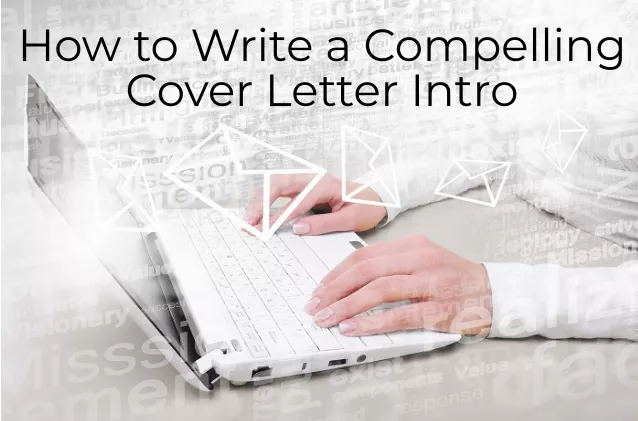
We show you how to start a cover letter by introducing yourself with conviction while shining a spotlight on the qualifications that make you an excellent fit for the job opportunity.
There are a number of ways to do this, we walk you through the process of developing a great introduction to your cover letter and provide effective examples of how to begin your cover letter.
5 key steps to write a good cover letter intro
1. Address the letter to someone by name
Get your cover letter off to the right start by ensuring your letter is addressed to an individual. Contact the company to get the full name, correct spelling and title of the person responsible for reviewing your resume.
Addressing your cover letter to "The Hiring Manager" or "To Whom it May Concern" immediately creates a disconnect between you and the reader.
2. Specify the job you are applying for
The hiring manager may be screening candidates for a number of different job openings so it is important to be explicit about the job you are applying for in your cover letter introduction.
3. Convey enthusiasm for the job
Show commitment from the word go by briefly articulating why you are excited about the job opportunity.
4. Highlight your suitability
Find out as much as you can about the job and company before writing your cover letter. You can then concisely introduce yourself as a well qualified candidate before going on to specify your relevant skills and experience in the body of your cover letter.
5. Tailor your cover letter intro for each job
Your introduction should be targeted to the specific job opportunity and company.
Good examples of how to introduce yourself in a cover letter
Specify the job opportunity and show your enthusiasm
Your online job posting regarding the ..... position immediately caught my eye and your company name caught my attention
Your recent job posting for the ..... position has captured my serious interest
I read your job description for the .... position with great enthusiasm
I was excited to read your ..... job posting
I was very pleased to learn of your need for a .....
Introduce yourself with conviction
I believe that I am particularly well qualified for this position, please allow me to highlight my skills as they relate to your requirements...
I believe that my qualifications and experience, as presented below, combine to create an excellent match for the position...
I am convinced that I have the skills and expertise to successfully fulfill your job needs...
The enclosed resume details my proven track record in a similar position, some key points you may find relevant include:
My previous work experience has equipped me with the skills and knowledge you are looking for, in particular ....
This position will utilize my extensive experience in ....
I am confident that I will make an immediate and valuable contribution to your company, my credentials for this job include:
As a results-driven professional I believe I am well suited to this job, highlights of my achievements include the following :
5 cover letter intro examples that get the results you want
Here are 5 effective ways to start your cover letter when you are submitting a job application..
1. Introduce yourself in a professional manner
Let the employer know you are a serious and well qualified candidate for the job by introducing yourself in a direct and straightforward way.
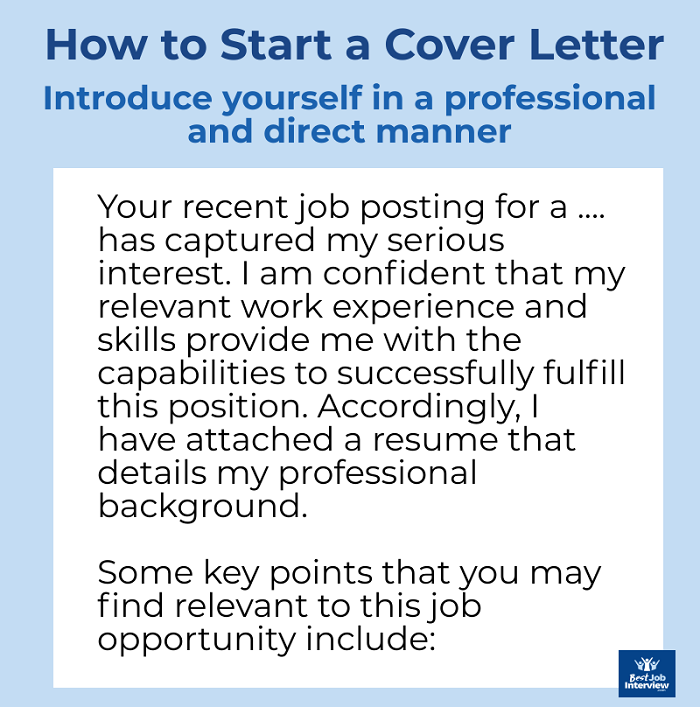
2. Introduce yourself with enthusiasm and conviction
Emphasize your genuine interest in the position and the company and state your confidence that you are an excellent candidate for the job.
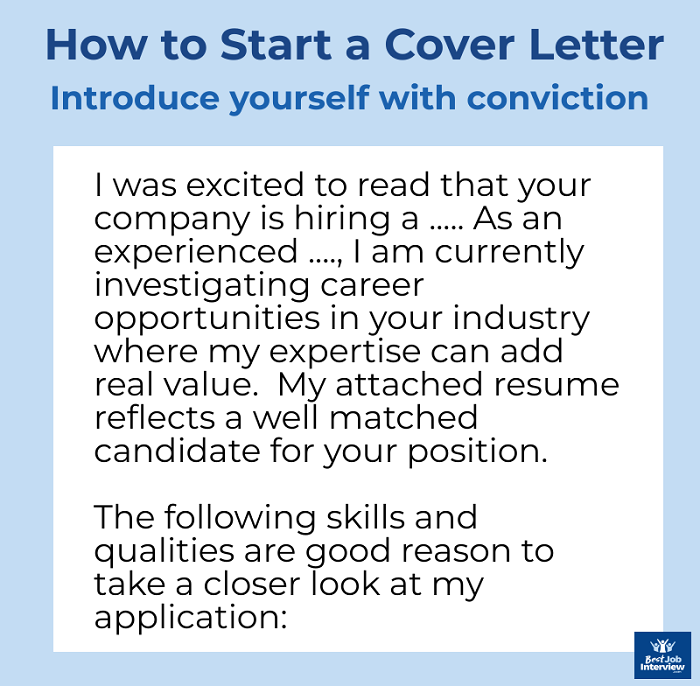
3. Focus on your suitability for the job opportunity
Why are you a good match for the job? Let the company know what you can offer them in this position.
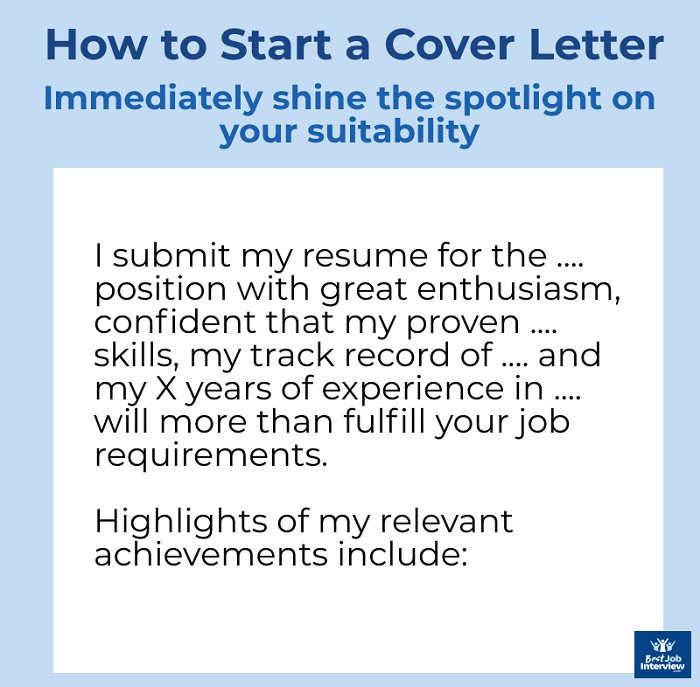
4. Articulate your passion for the job
Employers seek individuals who show genuine passion for the work they are doing. Combined with the right skills, passion is a top driver of success in a job.
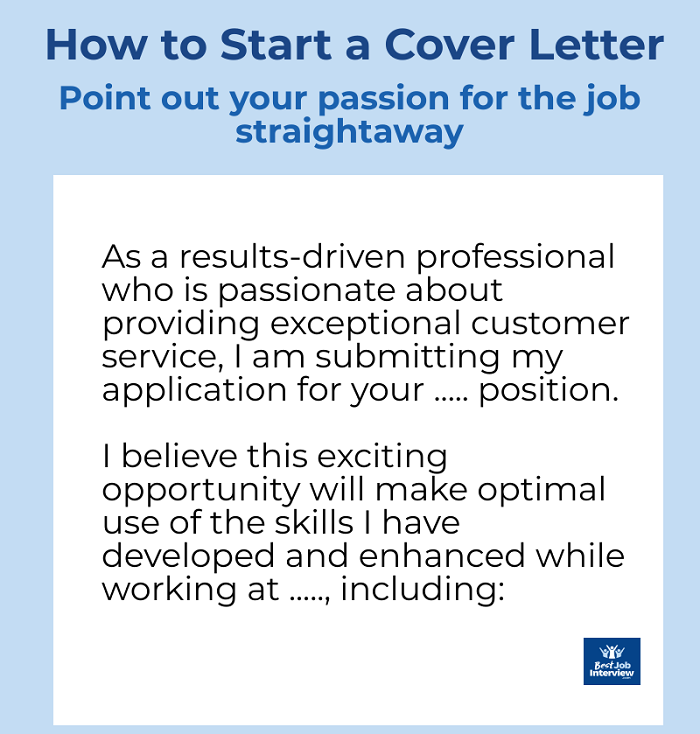
5. What makes you the best candidate for the job?
Use your cover letter intro to differentiate yourself from the competition. Start with a relevant and impressive accomplishment or skill that puts you ahead of the pack.
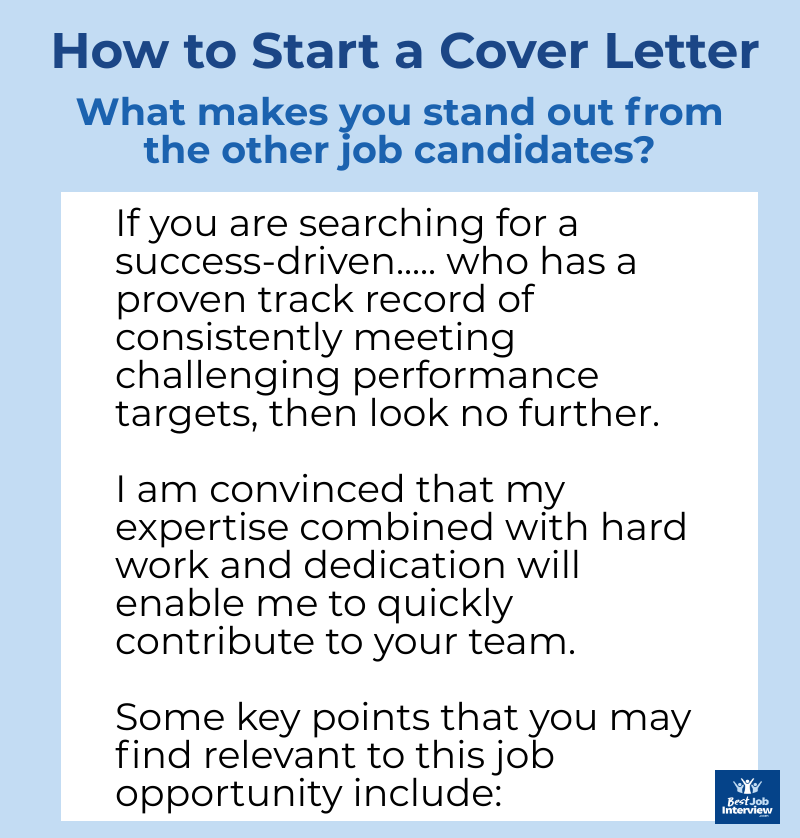
Once you have grabbed the reader's attention with a powerful cover letter intro, the next step is to maintain interest and create the desire to learn more about you.
This is achieved in the body of your cover letter which brings attention to the skills, knowledge, expertise, achievements, qualifications and experience that make you a successful candidate for this specific position. It is a concise and compelling summary of what makes you the right job candidate.
You can use the structure of this cover letter template to help you with this next step.
In addition we have over 50 sample cover letters for different jobs that you can easily adapt for your own use.
Closing your cover letter
How you close your cover letter is as important as how you start it.
It is essential to end with the right message and ensure the reader takes action and continues on to read your resume with serious interest.
Find out how to close a cover letter strongly with good examples.
Everything you need to write a powerful cover letter
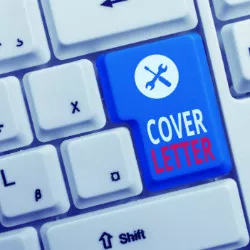
COVER LETTERS
Over 50 Sample Cover Letters
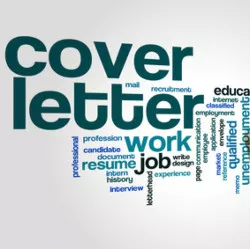
4 Cover Letter Formats
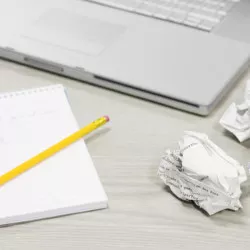
Sample Email Cover Letter
Gain a good understanding of the job requirements
In order to write an effective cover letter intro it is essential that you have a clear understanding of the job opportunity. Use these complete job descriptions to help you with this.
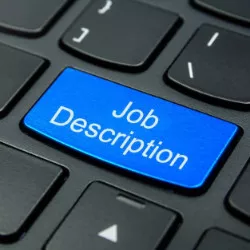
List of Strengths

Job Skills List
Submit a job-winning resume
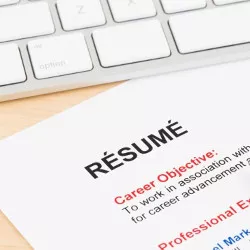
SAMPLE RESUMES
Over 50 Sample Resumes
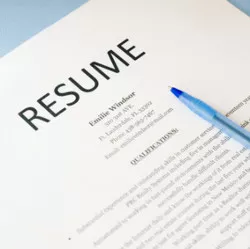
Sample Resume Template
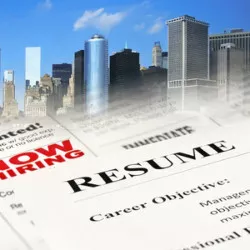
Top Resume Writing Tips
Don't Miss These Latest Updates
Problem-solving is a key skill for today's workplace. Problem-solving behavioral interview questions
Compelling sample interview answers to "Why do you want to work for this company?"
11 essential supervisor interview questions and answers plus industry specific supervisor Q&A .
How to ask for a letter of recommendation with this sample email requesting letter of recommendation .
What are the top 10 reasons for leaving your job? Find out acceptable reasons for leaving a job.
Sample employment acceptance letter and email to properly confirm your acceptance of the job offer and employment contract.
What are your strengths? Find out the 11 essential workplace strengths at list of strengths and weaknesses
Interview Preparation
Interview Questions & Answers
Interview Guides
After the Interview
The Job Offer
Latest News
© Copyright 2023 | Best-Job-Interview.com | All Rights Reserved.

A Perfect Letter of Introduction [Examples]
By Status.net Editorial Team on June 14, 2023 — 15 minutes to read
- How To Write a Letter of Introduction Part 1
- Types of Introduction Letters Part 2
- Letter of Introduction Template Part 3
- Templates: Letter of Introduction for Job Seekers Part 4
- Templates: Letter of Introduction for Networking Part 5
- Templates: New Team Member Letter of Introduction Part 6
- Employee to Customer Introduction Letter Template Part 7
- Business Introduction Template Part 8
- Tips for Writing a Perfect Letter of Introduction Part 9
A good letter of introduction can be a valuable tool in making new connections, whether for personal, professional, or business purposes. In this article, we’ll explore how to write a perfect letter of introduction.
To begin, it’s important to understand the difference between a letter of introduction and other forms of introductory communication. An introduction letter isn’t a cover letter – rather, it serves to establish relationships and spark interest.
Difference Between Introduction Letter and Cover Letter
An introduction letter is not a cover letter. While both documents are used to make introductions, they serve different purposes. An introduction letter is typically written to introduce yourself, your business, or a third party, whereas a cover letter is used when applying for a job or sending a proposal. In an introduction letter, you should briefly highlight your background, accomplishments, and goals, while in a cover letter, you should focus on how your skills and experiences relate to a specific job opportunity.
Introduction Letter vs. Letter of Recommendation
An introduction letter is also not a letter of recommendation. A letter of recommendation is written by someone who knows you well, like a former employer, teacher, or mentor, to vouch for your abilities and accomplishments. It often includes specific examples of your work and contributions, as well as why the person is recommending you for a certain position or opportunity.
Related: A Perfect Letter of Recommendation [8 Templates]
An introduction letter is written by you or on behalf of an individual or company to make an initial connection with others. While you might mention your skills and experience in an introduction letter, it doesn’t have the same weight or credibility as a letter of recommendation, since it lacks the endorsements from others.
Related: How to Ask for a Letter of Recommendation [Examples]
The Full Guide to Reference Letters [Best Templates]
- An introduction letter is used to introduce yourself, your company, or a third party to others.
- A cover letter is used when applying for a job or submitting a proposal, focusing on how your skills and experiences relate to the specific opportunity.
- A letter of recommendation is a formal endorsement of your abilities and accomplishments, written by someone who knows you well.
Remember to use the appropriate type of letter for each situation and adhere to the specific guidelines and tone for each document: this will ensure your communication is effective and appropriate, increasing your chances of making a positive impression.
Part 1 How To Write a Letter of Introduction
Format and structure.
To write an effective letter of introduction, start with proper formatting. Use a standard font, such as Arial or Times New Roman, and set the font size to 12. Stick to a formal tone, and use single spacing with a space between paragraphs.

Greeting and Opening Remarks
Begin your letter with a professional greeting. If you know the recipient’s name, use “Dear [Name].” If not, use “Dear [Title]” or “To Whom It May Concern.” Your opening remarks should briefly explain the purpose of the letter and introduce yourself or the person you are introducing.
Related: How to Start a Letter (and Mistakes to Avoid)
In the main body of the letter, provide details about yourself or the person you are introducing. Focus on the key qualifications, skills, and experiences that are relevant to the recipient. This is also an ideal place to mention any mutual connections or shared interests.
- Keep the paragraphs short and concise.
- Highlight your achievements or expertise.
- Use bullet points or tables to enumerate qualifications or experiences, if necessary.
Closing and Sign Off
To close the letter, express your gratitude to the recipient for their time and attention. Offer your assistance if they have further questions or would like additional information. Use a standard sign-off, such as “Sincerely,” “Best Regards,” or “Yours Faithfully,” followed by your full name and contact information (e.g., email, phone number).
Related: How to End an Email Professionally (Examples)
Remember to proofread your letter of introduction and ensure that spelling, grammar, and punctuation are accurate before sending it off.
Part 2 Types of Introduction Letters
Job-related introductions.
In job-related introduction letters, you are typically introducing yourself as a potential employee or applicant. This is useful when seeking new job opportunities, submitting your resume, or reaching out to potential employers. Your letter should showcase your skills, experience, and enthusiasm for the position while also expressing your interest in the company and its mission.
Networking Introductions
When networking, it’s important to make a great first impression by introducing yourself effectively. In a networking introduction letter, the goal is to establish a connection with an individual or a group within your industry. Mention your title, role, and any common acquaintances you may have. Also, highlight some of your accomplishments or notable experiences relevant to the people you’re introducing yourself to.
Agency or Freelancer Introductions
If you are an agency or a freelancer looking for clients, an introduction letter is a great way to showcase your services and expertise. The focus should be on how you can support the client’s needs and help them achieve their goals. Provide a brief overview of your industry experience, the services you offer, and some examples of successful projects or satisfied clients.
Team Introduction
In a team introduction letter, your objective is to introduce your team members to a new client, project team, or department. Detail the relevant qualifications, skills, and areas of expertise for each team member. This will help establish trust and confidence in your team’s abilities. Be sure to include contact information to facilitate further communication.
Letter of Introduction Examples
Part 3 letter of introduction template.
Dear [Recipient],
I hope this letter finds you well. My name is [Your Name], and I am writing to introduce myself to you. [Insert a brief sentence or two about yourself, such as your current position or relevant experience]. I am reaching out to you because [insert reason for writing the letter, such as expressing interest in a job opportunity or seeking to establish a professional relationship].
I am excited to learn more about your organization and explore opportunities for collaboration. Please feel free to reach out to me at [insert contact information] if you have any questions or would like to discuss further.
Thank you for your time and consideration.
Best regards, [Your Name]
Templates for various types of introduction letters:
Part 4 Templates: Letter of Introduction for Job Seekers
When you are seeking a new job, it’s essential to introduce yourself professionally. Here’s an example of a letter of introduction for job seekers:
Dear [Recipient’s Name],
I hope this message finds you well. My name is [Your Name] and I am writing to express my interest in the [Job Title] position at [Company Name]. I came across your job posting on [Job Board/Website] and believe my skills and experience make me an ideal candidate.
Throughout my career, I have worked on various projects focusing on [specific skills or subject matter]. At my previous job at [Previous Company Name], I [describe a significant achievement or responsibility]. Additionally, I am skilled in [list relevant skills] and have experience using [software or tools related to the job].
I have attached my resume for your review, which includes more information on my background and qualifications. I would appreciate the opportunity to discuss my suitability for the position during an interview. Please feel free to contact me at [Your Email] or [Your Phone Number] to schedule a meeting or for any further information.
Thank you for taking the time to consider my application. I look forward to hearing from you soon.
Sincerely, [Your Name] [Your Email Address] [Your Phone Number]
Related: Best Job Interview Request Email Responses (Examples)
Subject: [Your Name] – [Target Job Title]
I came across the [Job Title] opening at [Company Name] and after reviewing your company’s impressive accomplishments in [Industry], I believe that my [Number of Years] years of experience in a similar role make me an ideal fit.
Enclosed is my resume, which highlights my expertise in [Specific Skills or Accomplishments]. I am confident that my experience in [Area of Expertise] would make a valuable contribution to your team.
[Optional: Mention any mutual connections, if applicable.]
I would welcome the opportunity to discuss my qualifications further and explore how I could contribute to [Company Name]’s success. Thank you for considering my application.
Part 5 Templates: Letter of Introduction for Networking
A networking introduction letter aims to establish connections with potential clients, partners, or colleagues.
Subject: Introduction – [Your Name] and [Recipient’s Name]
Hi [Recipient’s Name],
I hope this message finds you well. I came across your profile while searching for professionals in the [Industry] field, and I am impressed by your experience and accomplishments.
As a fellow professional in the [Industry], I believe that connecting with like-minded individuals like yourself can greatly benefit both our careers. I am particularly interested in [Specific Area of Interest] and would appreciate any insights or advice you may have.
If you’re open to it, I’d love to set up a time to chat over a coffee or a quick phone call. Looking forward to your response.
Best regards, [Your Name] [Your Email Address] [Your Phone Number]
I hope this email finds you well. My name is [Your Name], and I am a [Your Profession or Title] at [Your Company or Organization]. I recently attended the [Event or Conference Name] and saw your insightful presentation on [Topic]. Your ideas resonated with me, and I believe your expertise could benefit the projects I am currently working on.
My current projects involve [briefly describe your projects, e.g., developing new software or implementing a marketing strategy]. I am eager to learn more about your work in [Recipient’s Field of Expertise] and would love to schedule a phone call or coffee meeting to discuss our shared interests and potential collaboration.
Please let me know when you are available, and I will be happy to make arrangements. You can contact me at [Your Email] or [Your Phone Number].
Looking forward to connecting with you.
Part 6 Templates: New Team Member Letter of Introduction
Template 1: introducing yourself.
When joining a new team, a letter of introduction helps introduce you to your colleagues and establish rapport.
Subject: Hello from [Your Name], your new [Job Title / Team Role]
Dear [Team Name or Colleagues],
I hope this email finds you all in good spirits. My name is [Your Name], and I am excited to join the [Company Name] team as your new [Job Title / Team Role]. It’s a pleasure to meet all of you!
A little bit about myself: I have been working in the [Your Industry] for [Number of Years] years, mainly focusing on [Area of Expertise]. My skills include [list relevant skills], and I am proficient in [software or tools you will be using].
In my spare time, I enjoy [mention personal hobbies or interests to connect on a personal level].
I am eager to contribute to the team’s success and look forward to learning from each of you. Please feel free to reach out if you have any questions or concerns, or if you would like to grab lunch or coffee together.
Thank you for the warm welcome, and have a great day!
Best, [Your Name]
Template 2: New Team Member
Welcome a new team member with this template, outlining their role and initial responsibilities.
Subject: Welcome [New Team Member’s Name]!
Dear [Existing Team Members],
Please join me in extending a warm welcome to our newest team member, [New Team Member’s Name]. [He/She/They] will be joining us as a [New Team Member’s Job Title] effective [Start Date].
[New Team Member’s Name] brings with them a wealth of experience in [Area of Expertise], having worked at [Previous Company] for [Number of Years Experience]. In their new role, they will be responsible for [Responsibilities].
We are excited to have [New Team Member’s Name] on board and look forward to their contributions as we continue to grow and succeed.
Please take the time to introduce yourself to [New Team Member’s Name] and offer any assistance they may need as they familiarize themselves with our processes and systems.
Best regards, [Your Name] [Your Title]
Part 7 Employee to Customer Introduction Letter Template
Introducing an employee to clients or customers:
Dear [Customer],
I am writing to introduce you to our newest team member, [Employee Name]. [He/She] is joining us as [Position/Title] and brings with [him/her] [Number] years of experience in [Industry/Specialization].
[Employee Name] is an expert in [Skill/Expertise] and has a proven track record of delivering exceptional [Service/Product]. [He/She] is committed to providing our customers with the highest level of service and ensuring that their needs are met with the utmost care and attention.
We are thrilled to have [Employee Name] on board and believe that [he/she] will be a valuable asset to our team and to our customers. [He/She] is excited to meet and work with all of you, and we are confident that you will find [him/her] to be a knowledgeable and helpful resource.
Please join me in welcoming [Employee Name] to our team and we look forward to continuing to serve you with excellence.
Sincerely, [Your Name] [Your Title] [Company Name]
Part 8 Business Introduction Template
Introduce your business to potential clients, partners, or investors with this template.
Subject: Introducing [Your Company Name]
I would like to take this opportunity to introduce you to [Your Company Name], a [Description of Your Business] that specializes in [Product/Service Offering]. We have successfully served clients in [Industry] for [Number of Years/Timeframe].
Our key services/products include: – [Service/Product 1] – [Service/Product 2] – [Service/Product 3]
We understand the challenges faced by businesses like yours in the [Industry] sector and have a track record of delivering solutions tailored to your needs. Our expertise in [Specific Area] allows us to offer you the best possible service.
We would be thrilled to explore how our offerings can provide value to your organization. Please don’t hesitate to reach out if you have any questions or would like to schedule a meeting.
Best regards, [Your Name] [Your Title] [Your Company] [Your Email Address] [Your Phone Number]
Part 9 Tips for Writing a Perfect Letter of Introduction
When writing a letter of introduction, it is important to keep it brief. Clearly state the purpose and get straight to the point. Remember, your recipient may have a busy schedule, so limit your introduction to a few paragraphs. Being concise ensures that your message is understood and remains memorable.
Use a Professional Tone
Maintain a professional tone throughout your letter of introduction. Be confident, knowledgeable, and clear. Avoid using casual language or informal expressions. This demonstrates your respect for the recipient and reflects well on your professionalism.
Include Contact Information
Ensure that you include your contact information, such as email address and phone number, so the recipient can easily reach you. This can be placed at the beginning or end of the letter. Including your contact information allows the recipient to respond and take the desired action.
Before sending your letter of introduction, proofread it carefully for errors in grammar, spelling, and punctuation. A well-written, error-free letter shows attention to detail and care in your communication. Ask a colleague or friend to review your letter for additional insights and suggestions.
Frequently Asked Questions
How do you start a good introduction letter.
To start a good introduction letter, ensure you have a clear purpose for the letter. Begin by addressing the recipient by name if possible and introducing yourself. State the reason for writing the letter and try to engage the recipient’s interest with a hook, such as a shared connection or a relevant accomplishment. Example:
My name is [Your Name] and I am writing to introduce myself and express my interest in [reason for writing the letter]. I hope this letter finds you well.
I wanted to reach out to you because [hook – shared connection or relevant accomplishment]. As someone who is [briefly describe your background or experience], I believe that I would be a valuable asset to your [company/organization/project].
I am excited to learn more about your work and how I can contribute to it. Please feel free to reach out to me at [contact information] to discuss this further.
Thank you for your time and consideration. I look forward to hearing from you soon.
What distinguishes a letter of introduction from other types of letters?
A letter of introduction is specifically written to introduce yourself, your business, or an employee to another party. It aims to establish a relationship, provide information about your expertise or service offerings, and potentially open up opportunities for collaboration. Unlike cover letters, which focus on a specific job position, introduction letters highlight your skills or experiences more broadly and are often used for networking purposes.
What are the different types of introduction letters?
Introduction letters come in various forms, such as:
- Business to Business (B2B) – Introducing a company, product, or service.
- Employee to Customer – Introducing an employee to clients or customers.
- Self-introduction – Introducing oneself for networking, job applications, or collaboration opportunities.
- New Hire Introduction – Introducing a new employee to the team or organization.
What are some effective tips for writing a letter of introduction?
- Be concise and clear about your purpose.
- Use a professional tone and language.
- Personalize the letter by addressing the recipient by name.
- Emphasize your strengths, experiences, or areas of expertise.
- Include a call-to-action, such as requesting a meeting or asking the recipient to review your attached documents.
- Proofread and edit your letter for grammar, spelling, and punctuation errors.
- How to Ask for a Letter of Recommendation [Examples]
- How to Start a Letter (and Mistakes to Avoid)
- How to End an Email Professionally (Examples)
- Emotional Intelligence (EQ) in Leadership [Examples, Tips]
- A Perfect Letter of Recommendation [8 Templates]
- Effective Nonverbal Communication in the Workplace (Examples)
How To Write A Letter Of Introduction For Job Seekers (Samples Included)
Jeff Gillis 0 Comments

By Jeff Gillis
Updated 6/14/2022.
For many job seekers, nothing’s more frustrating than the words, “It’s not what you know, it’s who you know.”
What if you don’t know anyone? Perhaps you’ve moved to a new city, switched industries, or simply didn’t recognize the importance of networking until recently. How can talented individuals in this situation play catch-up and get their careers started?
It isn’t impossible, and you don’t have to be obnoxious to get in front of the right people. In fact, there’s an entire method for introducing yourself to people you’ve never met but would like to know. It’s called sending a Letter of Introduction.
What Exactly Is a Letter of Introduction?
So, what is a letter of introduction? A letter of introduction is, according to Military One Source , correspondence that “notifies an employer of your qualifications and interest to be considered for potential future positions.”
However, it can also be more. For example, you could send a letter of introduction to a potential new network contact, allowing you to expand your circle.
Essentially, the letter of introduction is a way to reach out to someone asking to make their acquaintance and, if they’re willing, find out about job opportunities or forge new connections in your desired industry. It’s a polite way to get your name in front of important people without infringing on their time or accosting them in a coffee shop.
It’s also important to understand what an introduction letter is not. It isn’t your resume , it’s not a cover letter , and it’s not a short story detailing your early life, dreams, and ambitions. You don’t send one in response to a current job posting.
Instead, it’s a brief, clear, and concise explanation of who you are as a professional and why you are writing. This reason could be that you’re looking for a job, or you’re hoping to chat with them to gain some insight into the industry you wish to enter.
Types of Introduction Letters
An introduction letter can be used to introduce yourself to someone new or to introduce a friend or colleague to someone you know. Introduction letters are either formal or informal. Typically speaking, an informal introduction letter is used in the second case where Person A is introducing Person B to Person C.
How to Write the Different Kinds of Letters of Introduction
Writing an informal introduction letter to introduce someone to a third party is rather simple. Since you know the person you’re introducing them to, you can rely on your own judgment when choosing your wording. For this article, we’ll focus on a relatively formal letter, even if it’s to a colleague. Such a letter should include the following features:
- An explanation of why you’re writing
- A brief description of who you’re introducing them to, relevant details like their job, and how you personally know them
- A few lines on what that person needs (i.e., advice on entering the tech world with a finance background) and why you thought your colleague would be a useful resource
- The job seeker’s contact information, ideally both their telephone number and email address
Today, most people send letters of introduction via email. Be mindful of how you send that email. For instance, there’s a difference between sending a letter of introduction and a referral letter.
Let’s say your friend needs a freelance copywriter. You worked with a great copywriter previously, and you tell your friend you’ll send their details.
In this case, you’re mainly sending a referral, as you’re connecting a professional connection to a friend with a specific need. While this is an amazing thing to do – as 72 percent of interviews are referrals – it isn’t the same as a letter of introduction.
Now, let’s change the circumstances a bit. In this scenario, let’s pretend your friend owns a copywriting agency.
Your professional connection is looking for a full-time gig and asks you to introduce them to someone who works in an agency. When you send the message out, you aren’t referring your professional contact for a specific opening. Instead, you’re letting your friend know a bit about who they are and providing contact details that allow your friend to reach out to your professional connection if they so choose. That’s an introduction letter.
When writing a letter of introduction for yourself, the steps are almost identical with a few subtle differences:
- Dive right into who you are and what you do
- Include a few lines about why you’re writing to them and specific details about what you’d like from them, like industry insights or information on job opportunities.
- Provide information on how they can reach you, how you look forward to speaking with them, and a thank you for their time
- End with a respectful sign-off
Letter of Introduction Samples
In some cases, it’s far easier to see how to approach a situation by checking out a few examples. Here is a sample letter of introduction for when you’re writing on behalf of someone else and another for when you’re writing on behalf of yourself:
Introductory Letter on Behalf of Someone Else
Hi Jane Doe, It was a pleasure catching up with you at the networking event last week! I’d like to take a moment to introduce you to John Smith, a project manager with nearly a decade of experience, specifically in the technology niche. I’ve personally worked with him several times during his time with ABC Corp, and I’ve grown to trust his expertise over the years. Currently, John is exploring new opportunities and was hoping to connect with you about potential future openings at your company. I’ve attached his resume for you to review, and you can also find him on LinkedIn using the link in that document. If you’d like to touch base by phone, you can contact him at 555-555-5555. While I’m not aware of any current hiring needs on your end, I do believe John would be an asset. Sincerely, James
Introductory Letter on Behalf of Yourself
Dear John Doe, My name is Jane Smith, and I’m a marketing manager with ten years of experience in the field, focused mainly on the food and beverage space. I’ve long been a fan of your company – XYZ Inc. – particularly its recent campaign for leading snack food manufacturer ABC Co. If you have the time, I would love to talk to you about opportunities with your company, as well as gain career insights from a leader in the field, such as yourself. If you’re available, I can be reached at 555-555-5555. You can also reply to this email and view my portfolio using the link in my signature. Thanks for your time, and I look forward to hearing from you. Best, Jane Smith
These are rather formal examples of an introductory letter, focusing on professionals in the project management niche. Additionally, they’re relatively simple, showing you the general structure to follow.
In some cases, you could expand on various points based on the nuances of the company and what the job seeker has to offer. However, it’s crucial to keep things concise. Now isn’t the time to tell someone’s life story. Instead, the goal is to make an initial connection that can be built upon later.
It’s also true that less formal letters sometimes work. However, you don’t want to run the risk of alienating someone you don’t know with what feels like a gimmick or a sales letter. That’s why formal is often the way to go, regardless of whether you’re introducing yourself or someone else.
Use these examples as a letter of introduction template, giving you a solid starting point. Then, adjust the details as needed to ensure it makes the best possible impression.
Putting It All Together
A letter of introduction allows you to even the playing field when it comes to the game of “who knows who.” If you can dedicate time to send a letter (or email) of introduction each week to people you’d like to meet, a certain percentage will likely reply back – so long as you don’t simply cut and paste the same letter for everyone.
Whether it’s to land a new job or break into a new industry, take advantage of the power of introductory letters.

Co-founder and CTO of TheInterviewGuys.com. Jeff is a featured contributor delivering advice on job search, job interviews and career advancement, having published more than 50 pieces of unique content on the site , with his work being featured in top publications such as INC , ZDnet , MSN and more.
Learn more about The Interview Guys on our About Us page .
About The Author
Jeff gillis.

Co-founder and CTO of TheInterviewGuys.com. Jeff is a featured contributor delivering advice on job search, job interviews and career advancement, having published more than 50 pieces of unique content on the site , with his work being featured in top publications such as INC , ZDnet , MSN and more. Learn more about The Interview Guys on our About Us page .
Copyright © 2024 · TheInterviewguys.com · All Rights Reserved
- Our Products
- Case Studies
- Interview Questions
- Jobs Articles
- Members Login
- Search Search Please fill out this field.
- Career Planning
- Finding a Job
Letter of Introduction Examples and Writing Tips
:max_bytes(150000):strip_icc():format(webp)/ADHeadshot-Cropped-b80e40469d5b4852a68f94ad69d6e8bd.jpg)
Types of Introduction Letters
Tips for writing a letter of introduction, letter of introduction examples, letter introducing two people, letter introducing yourself, more introduction letter examples, related types of letters.
Sam Edwards / Getty Images
Do you need to write a letter introducing yourself to a prospective employer, a networking contact, or a potential new client? A well-written letter of introduction can result in a valuable relationship, and help you find a new job or acquire a new client. Learn why and how to send a letter, email, or LinkedIn message introducing yourself, so that you can make the best possible impression on the reader.
Surveys report that 70% to 80% (some even as high as 85%) of job seekers say that networking has helped them find a new job. However, this doesn’t mean that every networking success story involves a direct connection. Sometimes, it’s less about who you know, and more about who your friends know. A letter of introduction is one way to forge a new connection.
There are two types of letters of introduction.
- In the first type, you introduce a connection to someone else you know . That someone might be a potential candidate for employment, or someone looking for career assistance.
- In the other type of letter of introduction, you write to someone you haven’t met . You introduce yourself to ask them for a job referral or request assistance with a job search .
A letter of introduction can be a useful way to network and gain job search advice, or even possibly a job opportunity.
The most important tip to remember when writing a letter of introduction is to keep it short and to the point. The person you are contacting is a busy professional, and you want to get his or her attention right away.
Use a Professional Tone
When writing your letter, make sure the tone matches your relationship. If you are close friends, you can write in a slightly less formal style. However, if you are introducing yourself for the first time, make sure your letter is extremely professional.
Mention Who You're Introducing
First, include a quick introduction that explains who you are, or a short synopsis of the person you are introducing.
Explain Why You're Writing
Then, briefly describe what you would like to accomplish by sending your letter. Does the other person wish to apply for a job opening? Are you hoping to set up an informational interview for yourself? Be as clear as possible.
Share Your Contact Information
Conclude with a description of how the recipient of the letter can either get in touch with you or the third party. Make it as easy as possible for the recipient to respond.
Proofread and Edit
Whether or not you are already acquainted, be sure to thoroughly edit and proofread your letter before sending it.
In many cases, the letter can be sent via email, because that's the quickest and easiest way to connect.
This is a letter of introduction example for introducing two people. Download the letter of introduction template (compatible with Google Docs and Word) or see below for more examples.
The Balance
This letter is written as an introduction to connect two people, and is typically sent to someone you know well.
Letter of Introduction Example: Introducing Two People
Barbara Nygaard 123 Main Street Anytown, CA 12345 555-212-1234 barbara.nygaard@email.com
April 11, 2022
Bob Smith Talent Evaluation Acme Recruiting 123 Business Rd. Business City, NY 54321
I'm writing to introduce you to Janice Dolan, who I have the pleasure of being acquainted with through the Brandon Theater Group. I am the Technical Director for the group, as you know, and I have worked with Janice on several local theater projects. She is a terrific stage manager with over ten years of experience.
Janice is interested in relocating to the San Francisco area in the near future and would appreciate any recommendations you could offer her for conducting a job search for a theater position and any help you can provide with the logistics of relocating to California.
I've attached her resume for your review, and you can contact her at janicedolan@email.com or 555-555-5555. Thank you in advance for any assistance you can provide.
Signature (hard copy letter)
Barbara Nygaard
This letter is an example of a letter written to introduce yourself.
Letter of Introduction Example Introducing Yourself
Subject: Introduction From Katherine Sussman
Dear Mr. Randall,
My name is Katherine Sussman, and I am currently a recruitment associate for XYZ Recruiting. I have been working as a recruiter for the past three years.
I am interested in moving from recruitment work in a large corporation to internal recruitment for a nonprofit. I used to work in development for ABC Nonprofit and would love to bring my current skills to a similar nonprofit. I know you do this kind of work for Sunshine Nonprofit, and I would appreciate hearing a bit about your experience in this field. I would love to arrange a time to meet with you for an informational interview.
I have attached my resume for your review. If you have time for a brief conversation, please let me know. You can contact me via email (ksussman@email.com) or phone (555-555-5555). I look forward to hearing from you. Thank you so much.
Katherine Sussman
Here's more information on introducing yourself, including how to introduce yourself in an email, and tips for saying thank you for an introduction.
- How to Introduce Yourself in an Email
- Sample Thank-You Letter for an Introduction
- Tips for Writing a Letter Requesting Career Advice
People often confuse a letter of introduction with other types of job search letters:
A cover letter is a document sent with your resume and other job application materials. Your cover letter serves as an introduction to your resume. Sometimes, you’ll mention a referral from a mutual acquaintance who told you about the job or passed on the hiring manager’s name. The letter explains why you are qualified for the specific job for which you are applying.
A referral letter is a letter you write to someone you don’t know following a lead by a mutual acquaintance. In the letter, you would begin by mentioning your common contact, and then make your request—perhaps you are applying to a job they have available, or you are looking to conduct an informational interview or learn about career opportunities.
A letter of recommendation is a letter written by someone who is familiar with your academic work or your job skills and can endorse your candidacy for a position. The letter would be addressed to the admission officer, department head, or hiring manager, and would include specific skills and experiences that highlight your suitability for the position you’re applying to.
Key Takeaways
- A letter of introduction can forge a new connection. Use these letters to introduce yourself to a potential new client or employer, or to do the same for one of your contacts.
- Keep your letter concise and to the point. The reader is a busy professional. State your purpose early on.
- Consider sending your introduction via email. If time is of the essence, emailing your note can help make an introduction quickly.
- Edit and proofread before sending. Even if you know the recipient well, make sure your letter is perfect before you mail or send it.
PayScale. " How Many Jobs Are Found Through Networking, Really ?"
Thousands of Jobs From US, Canada and Europe
The perfect introduction to your application
The introductory sentence of the cover letter in particular causes problems for many applicants. We’ll give you a few tips and tricks on how to create the perfect introduction to your application.
Dear Ladies and Gentlemen,
I hereby apply…
At this point in the cover letter, most HR managers have already fallen asleep or – if the applicant is lucky – would rather look at the CV first . In the best case scenario, the introduction to your application letter should not only attract the attention of the recruiter, but above all increase their interest in your application.
Because while a CV only contains facts, you can use examples to prove your strengths in the letter of application and also convince on an emotional level – but you have to read it first. We reveal how you can do this.
The introduction to the application: That’s why it’s important
The cover letter is always the first document in your application. Although many recruiters start with the CV, the cover letter is usually the first thing your potential employer sees of your application. And as everyone knows, first impressions matter.
For this reason, the introduction should not only be error-free , but also:
- encourage further reading,
- arouse the interest of the staff,
- convince the recruiter of your qualifications
- and explain your motivation.
It is understandably not that easy to fit all of this into just two or three sentences. For this reason, we will give you a few examples below of how to write a successful introductory sentence for your application .
You should avoid this in the introductory sentence of your application
Before we start giving you examples of how to write a compelling introduction to your cover letter, let’s first clarify what things you should avoid – and why.
Please no empty phrases
As the beginning of this article already suggests, you should never fall back on common phrases. Most HR managers have read phrases such as ” I hereby apply… ” and ” I read your job advertisement with great interest ” so often that they would like to go straight to the next application. Adopting ready-made texts or copying sentences from templates is not only inauthentic, but will immediately attract negative attention from most readers.
You only have limited space on your cover letter to convince your potential employer of you – so use it to introduce yourself.
No repetitions
You should also avoid empty phrases in the introductory sentence of your cover letter because they don’t tell the reader anything new . It is self-evident that you want to apply for a job with your application. Likewise, that you are obviously interested in the job advertisement – otherwise you would not have responded to it. Much more important is: What is your motivation for this application and what qualifies you for this job?
Avoid the subjunctive
Had, would, could – the subjunctive has no place in a cover letter and this also applies to the introduction. It gives the impression that you are not sure yourself whether you are really suitable for the position.
“I would be happy if I could support your team with my professional competence.”
“With my professional competence, I am the right addition to your team.”
While the first sentence seems polite, the second variant exudes much more self-confidence . You want to convince the HR manager in the introduction to your application letter – you should also express this verbally.
No exaggerations
While confidence is important in the introduction to your application, be careful not to brag. With an exaggerated self-confidence one attracts attention, but in the rarest of cases positively.
So don’t start your introductory sentence with: ” Stop searching because you have found the perfect candidate for your job opening in me. Not only does this set the bar very high for the subsequent cover letter, it also comes across as arrogant.
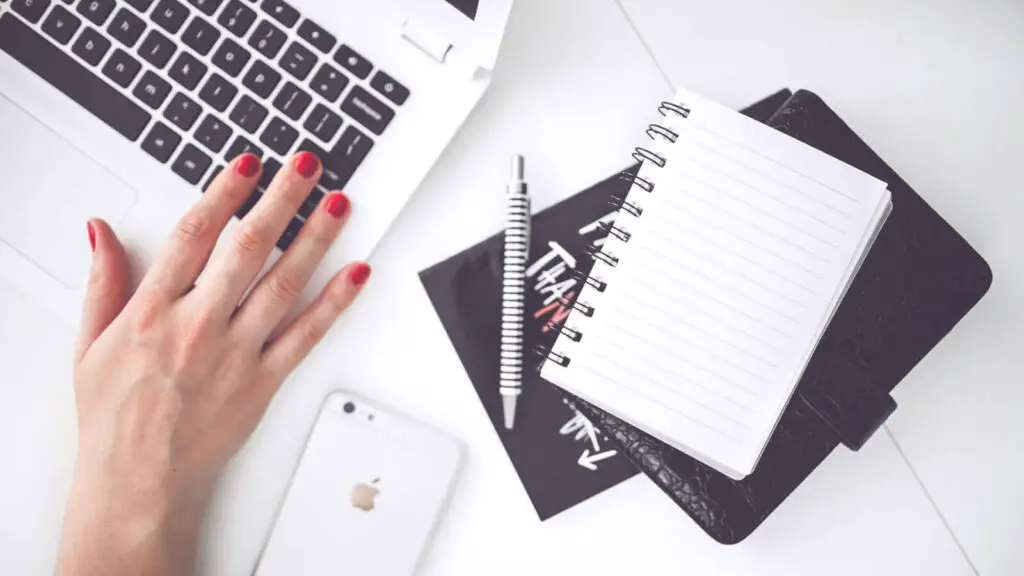
Tips for a good introduction to your cover letter
Now that you know what to avoid, we have some tips for you on how to start your cover letter in a convincing manner. However, a cover letter is always individual and should not only be tailored to you, but also to the company you are applying to.
For this reason, you should carefully consider in advance which appearance suits the desired position. In some sectors, such as banking, a serious appearance is essential. In other areas, such as an advertising agency, creativity is welcome. You should adapt your language and thus the introduction of your application accordingly.
The right speech
The perfect introduction does not start with the first sentence, but with the right speech. ” Dear Sir or Madam ” is not incorrect, but it comes across as impersonal and, in the worst case, can give the impression that it is a mass application.
On the other hand, taking the time to find out the name of your contact will make a better impression. You can often find the name in the job advertisement or on the company website. Of course, you also have the option of inquiring about a contact person by phone – this way you can also briefly introduce yourself in person. If, despite all your efforts, you cannot find out a name, it is of course perfectly fine to use the general form of address in your application.
Connect to personal conversations
If you have already contacted your potential employer before writing your application, it is a good idea to mention this in the introduction to your application letter. This applies, for example, if you presented yourself at a job fair or perhaps had a telephone interview to inquire about the position.
If you mention the meeting or the phone call, the recruiter will probably remember you, which automatically gives your cover letter more personality . It also confirms your interest if you introduce yourself in writing after the interview.
“Dear Ms. Hahn,
First of all, I would like to thank you for the friendly conversation we had on May 1st, 2020 at the career fair in Cologne. Your presentation of the company structure convinced me that I am the right candidate to support your team with my professional competence.”
Start with your qualification
If you want to tailor your cover letter to the position in question, you should first analyze the job advertisement. Which competences, soft skills and experiences are desired or required? In your cover letter, you should provide examples showing why you meet these requirements.
If you want to stand out from the crowd, you start the introductory sentence of your application with a meaningful argument .
“Dear Mr. Meyer,
Thanks to my many years of professional experience as an engineer, I am the right manager for your project. In the last five years as a project manager in the engineering company, I not only took on the project planning and the distribution of tasks within my team, but also the communication with our customers. For this reason, I am sure that I can meet the high demands that you place on your employees.”
Technical expertise
If you are an expert in your subject, you can also demonstrate this directly in the introduction to your application letter. Another possibility is to address current political or social events that are directly related to the industry. However, this variant is only recommended if you are really familiar with the field. If you make an uninformed statement, this is probably a direct exclusion criterion in case of doubt.
“Dear Mrs. Schneider,
From what I’ve seen from recent media coverage, your company is working to add the new Smart technology to its customer support. Thanks to my extensive experience in dealing with this smart technology, I am the right candidate to support your company with the implementation.”
Illustrate your motivation
You also have the option of beginning the introductory sentence of your application with your motivation for the position. Why are you applying for this particular job? Is there an aspect that is particularly important to you? A general line like ” I read your job ad with great interest ” says nothing about what really interests you about the job.
You could start the introduction to your cover letter with your beliefs .
“Dear Ms. Schmidt,
You care about the environment – it is also particularly important to me. During my school days I was involved in various environmental protection organizations and finally decided to study marine biology to protect our oceans. It is precisely for this reason that I would like to support you in your research institute.”
You could also use a little anecdote to describe a moment that shaped your career choice. This type of introduction gives your application a very personal touch and, at best, arouses the emotions and interest of the recruiter.
Start with a question
You can also start your cover letter with a question. A simple tactic that can already attract attention, because now the reader also wants to know the answer.
“Dear Mr. Cook,
What qualities do you need as a media clerk? Organizational talent, creativity and negotiation skills – I was able to prove that I have exactly these skills during my apprenticeship.”
This example shows how you can make the introduction to your application interesting and informative with just a few words. It proves that you have studied the job advertisement and know what skills are required. At the same time, it reveals where you are in your life.
Of course, you cannot put all the important information in three sentences. After all, the main purpose of the introduction is to arouse interest and encourage further reading. Nevertheless, if possible, you should briefly explain what professional situation you are in at the moment – the job you are applying for should not be in the introduction, but in the subject line.
You can apply all of these tips, whether you are applying for a full-time job, an apprenticeship or an internship. However, unsolicited applications are a special case.

General wording tips
In addition to the content of the introduction, the language design is also important. Here are some things to keep in mind when drafting.
- Avoid snake sentences: Short, concise sentences are easier to understand and increase the chance that the introduction to your application will be read.
- Active formulation: Make sure that you formulate your sentences actively, as this will appear more self-confident.
- Use positive adjectives: You can easily evoke positive emotions in your reader with certain words. Impressive, ideal, appealing, enthusiastic – words like these evoke positive associations.
As you can see, there are several ways to start initiating your application. Above all, you should make sure to remain authentic . So you shouldn’t pretend years of interest in a company just to make an impression. Or boast about skills that you don’t even have – because lies are usually discovered.
Don’t just refer to your positive qualities, but also highlight what stood out to you about your potential employer – this way you show that you have engaged with the company. It’s important to be aware of who the recipient of your application is – in a serious industry, a humorous introduction to your cover letter may not be the best solution.
In general, humor in your application is something that you should be careful with: You may put a smile on your reader’s face and make a likeable impression. But it can also give the impression that you are not taking the application seriously. And maybe the HR manager and you have completely different ideas about what is funny. So think carefully about how you want to present yourself.
When formulating the introduction to your application, however, you should not forget one thing: the most creative start is useless if there are mistakes. Therefore, ask a friend or family member to proofread your cover letter.
Related posts:

Finding a Job , Communication and Networking , CV and Cover Letter , JOB HUNTING , Job Interview Tips
Tags: The perfect introduction to your application
Leave a Reply Cancel reply
Save my name, email, and website in this browser for the next time I comment.
Got a question?
We're here to help. Check out our FAQs, send us an email or call us at 1 800 555 5555

IMAGES
VIDEO
COMMENTS
4. Mention something newsworthy. Start your cover letter with evidence that you've done your research. If the company you're applying for was recently in the news, mention it in the opening line and explain why you admire the company. Mention a specific event, fact, notable statistic or award the company recently won.
This is the initial greeting and sets the tone for the letter. Use a formal tone like "Dear [Recipient's Name]". If the recipient's name is unknown, "Dear Hiring Manager" or "To Whom It May Concern" are alternatives. Personalizing the salutation, however, is preferable if you know the recipient's name.
12 winning ways to start your cover letter. Our sample cover letter introductions will help you learn how to open a cover letter in a way that stands out and boosts your chances of landing an interview. 1. Mention a contact within the company. If you were referred by a former coworker, classmate, or friend who's highly regarded in their ...
Communicate that you'll bring something to the company: You'll get more into the details after your opening, of course. But your cover letter opener should still tell the reader, "This person can do something for us ," rather than, "This job would really help them .". Stick to the point: Your opener, while creative, should still be ...
Here's a simple-but-powerful cover letter introduction template to use as an example: Dear [First Name], I was excited to come across the [Job Title] position at [Company Name]. As a [Current Job Title] with [# of Years] years of experience, I have become competent in [Relevant Skills & Job-Related Abilities].
No hard numbers. "I worked in a team and provided customer service to elderly residents". 5. Choose engaging words for your application letter. Your letter of application's length should be 250 to 400 words or 3 to 4 paragraphs — long enough to get your point across but short enough that the reader won't lose interest.
Personalize Your Cover Letter. What to Write in the Rest of Your Letter. Cover Letter Sample. More Cover Letter Examples and Templates. Photo: Theresa Chiechi / The Balance. Examples of opening sentences to use when writing a cover letter, with tips for how to start and what to include in each part of a cover letter for a job.
Choose an appropriate font for your application letter, like Calibri or Helvetica. Set the font size between 10 and 12 pt. Adjust margins to at least 1 inch on all sides. Use 1.0 or 1.15 line spacing and insert an additional line between paragraphs. Align text to the left or use justified alignment.
Respectfully, Kind regards, Best regards, Yours truly, Then, make two spaces below the salutation, and type your full name. For some professional (but optional) flair, sign your cover letter either with a scan of your signature or by using software like DocuSign. 8. Check your cover letter's content and formatting.
Header - Input contact information. Greeting the hiring manager. Opening paragraph - Grab the reader's attention with 2-3 of your top achievements. Second paragraph - Explain why you're the perfect candidate for the job. Third paragraph - Explain why you're a good match for the company.
Letters of application are essential in the job market, so don't risk losing to other candidates just because you didn't write one. 2. Address Your Letter of Application Properly. Addressing an application letter is simple. Firstly, include your contact information in the header of the application letter : Full name.
Format of an Application Letter. Create enough spacing: 1-1.15 between lines, 1-inch margins, double space between paragraphs. Choose the font: Garamond, Helvetica, or Arial in 11-12 points in a font size. Align the content to the left. Pick the file format: PDF, unless the recruiter requested a Word file specifically.
Here are 5 effective ways to start your cover letter when you are submitting a job application.. 1. Introduce yourself in a professional manner. Let the employer know you are a serious and well qualified candidate for the job by introducing yourself in a direct and straightforward way. 2.
A cover letter is only ever sent as part of a job application, whereas an introduction letter can be sent for all kinds of purposes. An introduction letter should only be a couple of paragraphs long, whereas a cover letter may be around one page. The introduction letter is mostly sent via email or through platforms such as LinkedIn, but you can ...
Team Introduction. In a team introduction letter, your objective is to introduce your team members to a new client, project team, or department. Detail the relevant qualifications, skills, and areas of expertise for each team member. This will help establish trust and confidence in your team's abilities.
Include a few lines about why you're writing to them and specific details about what you'd like from them, like industry insights or information on job opportunities. Provide information on how they can reach you, how you look forward to speaking with them, and a thank you for their time. End with a respectful sign-off.
A cover letter is a document sent with your resume and other job application materials. Your cover letter serves as an introduction to your resume. Sometimes, you'll mention a referral from a mutual acquaintance who told you about the job or passed on the hiring manager's name.
Avoid the subjunctive. Had, would, could - the subjunctive has no place in a cover letter and this also applies to the introduction. It gives the impression that you are not sure yourself whether you are really suitable for the position. "I would be happy if I could support your team with my professional competence.".
A cover letter for an internship, also called a letter of introduction, an application letter, or a personal statement, expresses how your skills and experiences make you the best candidate for the position. It should showcase your personal style while expanding upon and complementing your résumé. Always include a cover letter when it is requested to solidify your chance of becoming a ...
A cover letter is a note that you write to a recruiter or hiring manager when applying for jobs. It should act as an introduction to you and back up your CV, which sits alongside it.
Application Letter Samples: An application letter is an important document. You need to be careful and formal while writing an application letter. It is an introduction letter that will give an appropriate picture of you. When you start writing the application letter, you need to keep the first paragraph short and precise. Additionally, you should […]
Across the business world, people are gaining access to jobs, contracts, and networking opportunities by sending an important document. This document is called a letter of introduction, and it is different from cover letters, letters of recommendation, reference letters, and even job application letters. This letter is just as important, and sometimes, depending on your industry and the ...
A letter of introduction is an email that formally connects one person to another, often intended to forge new relationships, collaborations, or networking opportunities. You may write an introduction letter to connect two people you know, introduce a new team member to your department, or introduce yourself to someone you want to know. ...
When you're ready to begin the application process, write your cover letter, review a resume sample and upload a resume file or build an Indeed Resume to begin your veterinarian job search. Andy Jenkins. Palo Alto, California. 771-555-0199. [email protected] May 9, 2023 Dear hiring manager, My name is Andy Jenkins, and I'm delighted to ...